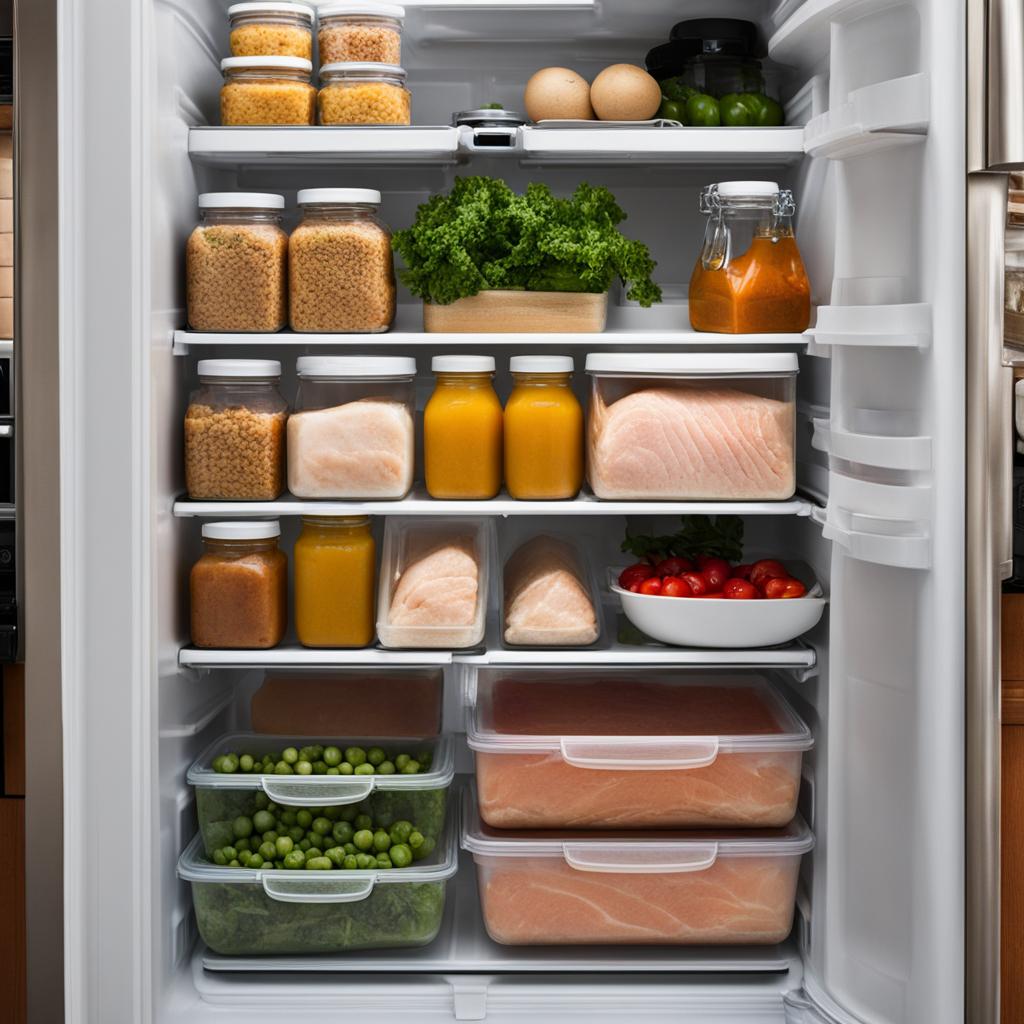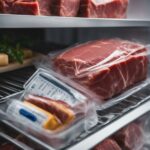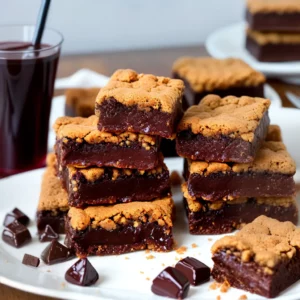Hello and welcome! Today, I want to talk about a topic that is crucial for every home cook: how to store chicken safely. Properly storing chicken is not only essential for maintaining food safety but also for preserving its freshness. By following the right storage methods and best practices, you can ensure that your chicken stays safe to consume and remains delicious. So, let’s dive in and explore the key guidelines for storing chicken!
Key Takeaways:
- Storing chicken properly is crucial for food safety and maintaining freshness.
- Refrigerate raw chicken in its original packaging in the coldest part of the refrigerator for up to 48 hours.
- Freeze chicken by wrapping separate pieces in foil or plastic bags, removing all air, and storing them in a larger freezer bag or foil wrap.
- Cooked chicken should be refrigerated within two hours of cooking and consumed or discarded within two to three days.
- Thaw frozen chicken safely in the refrigerator, not at room temperature, to prevent bacterial growth.
Refrigeration Guidelines for Raw Chicken
When it comes to storing raw chicken, proper refrigeration is key. By following the right guidelines, you can ensure the safety and freshness of your poultry. Here are some important tips to keep in mind:
- Keep raw chicken in its original packaging to prevent cross-contamination. Place it in the coldest part of your refrigerator, typically the bottom shelf or meat drawer.
- Refrigerate raw chicken for up to 48 hours after purchase. If you don’t plan to use it within that time frame, it’s best to freeze it.
- The storage times for different types of raw chicken vary. Chicken parts like breasts, thighs, and wings typically stay fresh for 1 to 2 days in the refrigerator, while whole chicken can last up to 2 days. If you choose to freeze raw chicken, it can be stored for up to 1 year.
By following these guidelines, you can keep your raw chicken safe and ready for cooking whenever you need it. Remember to always practice good food safety habits to prevent the risk of foodborne illnesses.
| Type of Chicken | Refrigeration Storage Time | Freezing Storage Time |
|---|---|---|
| Chicken parts (breasts, thighs, wings) | 1 to 2 days | Up to 1 year |
| Whole chicken | Up to 2 days | Up to 1 year |
Proper refrigeration is crucial for storing raw chicken safely. Always remember to keep it in its original packaging and store it in the coldest part of your fridge. Follow the recommended storage times to maintain the quality and prevent the risk of spoilage.
Now that you know the refrigeration guidelines for raw chicken, you can confidently store your poultry and enjoy delicious meals without compromising food safety.
Freezing Chicken Properly
When it comes to storing chicken, freezing it properly is a key step in maintaining its quality and freshness. By following the right storage methods, you can ensure that your frozen chicken stays safe to consume.
To freeze chicken effectively, start by wrapping each piece individually in foil or plastic bags. This will help prevent freezer burn and maintain the chicken’s moisture. Then, place the wrapped chicken in a larger freezer bag or foil wrap to provide an additional layer of protection. Make sure to remove all air from the package to prevent potential freezer burn and label it with the contents and date frozen. This way, you can easily keep track of how long the chicken has been frozen.
Properly frozen chicken can be stored in the freezer for different periods of time depending on its type:
| Type of Frozen Chicken | Storage Time |
|---|---|
| Chicken patties | 3-4 months |
| Individually quick-frozen chicken breasts | 9-12 months |
When thawing frozen chicken, it’s recommended to do so in the refrigerator to maintain its quality and minimize bacterial growth. Place the chicken on a plate or in a container to catch any drips and prevent cross-contamination with other foods. Avoid thawing chicken at room temperature, as it can promote the growth of harmful bacteria.
Summary:
- Wrap chicken pieces individually before placing them in a larger freezer bag or foil wrap.
- Remove all air from the package to prevent freezer burn.
- Label the package with the contents and date frozen for easy tracking.
- Thaw frozen chicken in the refrigerator to maintain its quality and minimize bacterial growth.
Refrigeration Guidelines for Cooked Chicken
When it comes to storing cooked chicken, proper refrigeration is crucial to maintain its freshness and prevent the growth of harmful bacteria. Following the right guidelines will help ensure that your leftovers remain safe to consume.
Refrigeration Time:
For cooked, cut-up chicken pieces, it is recommended to refrigerate them for two days or less. Whole cooked chicken can be kept in the refrigerator for three days or less. It’s important to note that the quality and safety of the chicken may start to decline after these time periods, so it’s best to consume it sooner rather than later.
Storage Tips:
When refrigerating cooked chicken, it is important to store it separately from raw foods to avoid cross-contamination. Use airtight containers or wrap the chicken tightly in plastic wrap or aluminum foil to prevent exposure to air, which can lead to the loss of moisture and quality. Label the container with the date it was stored to help keep track of its freshness.
Food Safety:
When handling cooked chicken leftovers, it’s crucial to prioritize food safety. Refrigerate the chicken within two hours of cooking to prevent bacterial growth. If you’re not planning to consume the leftovers within the recommended timeframes, consider freezing them for later use.
| Food Item | Refrigeration Time |
|---|---|
| Cooked, cut-up chicken | 2 days or less |
| Whole cooked chicken | 3 days or less |
Proper refrigeration of cooked chicken is crucial to maintain its safety and quality. By following these guidelines, you can ensure that your leftovers remain delicious and free from any potential risks.
Freezing Cooked Chicken
When it comes to storing leftover cooked chicken, freezing is a great option to prolong its shelf life. By following proper storage guidelines, you can ensure that your cooked chicken remains safe and flavorful for future use.
Proper Freezing Techniques for Cooked Chicken
Here are some tips for freezing cooked chicken:
- Allow the cooked chicken to cool for a couple of hours, loosely covering it to prevent condensation. This allows it to cool quickly and avoids the growth of bacteria.
- Tightly cover the cooled cooked chicken with airtight freezer-safe containers or heavy-duty freezer bags.
- Label the containers with the current date and contents. This makes it easier to keep track of the storage time.
- Store the containers in the coldest part of the freezer, preferably at or below 0°F (-18°C).
Storage Guidelines
Refrigerated leftover cooked chicken should be consumed or discarded within three to four days. However, frozen cooked chicken can be kept for a longer period, usually three to four months, without a significant decline in quality.
| Storage Method | Refrigerated Leftover Cooked Chicken | Frozen Cooked Chicken |
|---|---|---|
| Storage Time | 3-4 days | 3-4 months |
Remember to thaw frozen cooked chicken safely before reheating or using it. It is recommended to thaw it in the refrigerator overnight or using a microwave’s defrost function. Avoid thawing chicken at room temperature, as it can increase the risk of bacterial growth.
By following these guidelines, you can enjoy the convenience of having cooked chicken readily available in your freezer, ensuring minimal food waste and maximum flavor for future meals.
Proper Handling and Hygiene Tips
When it comes to storing chicken safely, proper handling and hygiene practices are of utmost importance. Following these tips will help you prevent cross-contamination and ensure food safety:
1. Wash Your Hands
Start by washing your hands thoroughly with soap and hot water before and after handling raw chicken. This will help eliminate any bacteria that may be present on your hands.
2. Keep Raw Chicken Separate
Avoid cross-contamination by keeping raw chicken separate from other foods, especially those that are ready to eat. Use separate cutting boards, utensils, and plates to avoid spreading bacteria.
3. Store Chicken Properly
| Storage Method | Guidelines |
|---|---|
| Refrigeration | Keep raw chicken in its original packaging and place it in the coldest part of the refrigerator. Use within 48 hours or freeze for longer storage. |
| Freezing | Wrap chicken pieces individually in foil or plastic bags, remove air, and store in a larger freezer bag or foil wrap. Label with contents and date frozen. |
4. Clean and Sanitize Surfaces
After handling raw chicken, clean and sanitize all surfaces, utensils, and cutting boards that came into contact with the chicken. Use hot, soapy water and a sanitizer to ensure thorough cleanliness.
By following these simple handling and hygiene tips, you can minimize the risk of foodborne illnesses and keep your chicken safe to consume.

Defrosting and Thawing Chicken
When it comes to preparing frozen chicken for cooking, defrosting and thawing it properly is crucial for ensuring kitchen safety and maintaining the quality of the meat. There are several safe methods for defrosting chicken, but it’s important to avoid certain practices, such as thawing it at room temperature, as they can promote bacterial growth. Let’s explore the recommended ways to defrost and thaw chicken effectively:
1. Refrigerator Method
The safest way to defrost chicken is by placing it in the refrigerator. This slow and steady method allows the chicken to thaw gradually while maintaining its overall quality. To defrost chicken using the refrigerator method, follow these steps:
- Place the frozen chicken in a leak-proof bag or container to prevent any drips that may contaminate other foods in the refrigerator.
- Set the temperature of your refrigerator to below 40°F (4°C) to ensure the chicken stays cool enough to prevent bacterial growth.
- Allow the chicken to thaw in the refrigerator, which typically takes about 24 hours for every 5 pounds of chicken.
This method requires some planning ahead, as it may take several hours or overnight for the chicken to fully defrost. However, it is the safest method that minimizes the risk of bacteria growth.
2. Cold Water Method
If you need to thaw chicken quickly, you can use the cold water method. Although faster than the refrigerator method, it requires more hands-on attention to ensure food safety. Here’s how to thaw chicken using the cold water method:
- Place the frozen chicken in a leak-proof plastic bag, ensuring that it is tightly sealed to prevent water from entering.
- Fill a large bowl or sink with cold water and submerge the bag of chicken in the water.
- Change the water every 30 minutes to ensure it stays cold and continues to thaw the chicken.
- Thawing chicken using this method usually takes about 30 minutes per pound of chicken.
It’s important to note that once the chicken is thawed using the cold water method, it should be cooked immediately to avoid any risk of bacteria growth.
By following these proper defrosting and thawing methods, you can ensure that your chicken is safe to cook and will retain its quality and taste. Remember to always practice good kitchen safety and hygiene when handling and preparing chicken to minimize the risk of foodborne illnesses.
| Defrosting Method | Time Required | Precautions |
|---|---|---|
| Refrigerator Method | Around 24 hours for every 5 pounds of chicken | Ensure chicken is placed in a leak-proof bag or container to prevent cross-contamination with other foods in the refrigerator. Set the refrigerator temperature below 40°F (4°C). |
| Cold Water Method | Approximately 30 minutes per pound of chicken | Use a leak-proof plastic bag, change the water every 30 minutes, and cook the chicken immediately after thawing. |
Proper Cooking and Reheating Techniques
When it comes to ensuring the safety of your chicken, proper cooking and reheating techniques are crucial. It’s important to cook chicken thoroughly to kill any bacteria that may be present. Use a food thermometer to check that the internal temperature of the chicken reaches 165°F (74°C). This ensures that any harmful bacteria present in the chicken is destroyed, reducing the risk of foodborne illnesses.
When reheating cooked chicken, it’s equally important to reach the same internal temperature of 165°F (74°C). This ensures that any bacteria that may have grown during storage or handling is killed. Avoid reheating chicken more than once, as repeated heating and cooling can increase the risk of bacterial growth.
Remember, cooking and reheating chicken is not just about reaching the right temperature, but also about maintaining kitchen safety. Follow these kitchen safety tips to ensure the best outcome:
- Always wash your hands thoroughly with soap and hot water before handling chicken.
- Use separate cutting boards and utensils for raw and cooked chicken to avoid cross-contamination.
- Clean and sanitize all surfaces and utensils that come into contact with raw chicken.
- Do not leave cooked chicken at room temperature for more than two hours to minimize the risk of bacterial growth.
By following these proper cooking and reheating techniques, you can enjoy delicious and safe chicken meals.
| Food Safety Tip | Internal Temperature |
|---|---|
| Chicken | 165°F (74°C) |
Choosing the Right Storage Containers
When it comes to storing chicken, selecting the right storage containers is key to maintaining its quality and safety. Airtight and sealed containers are essential for keeping out air and moisture, which can lead to freezer burn and spoilage. Additionally, proper packaging helps to prevent cross-contamination and keeps your chicken fresh for longer.
There are several options available for storing chicken, depending on your needs. Vacuum-sealed bags are a great choice for long-term storage in the freezer, as they remove excess air and help maintain the quality of the meat. Ziplock bags are a convenient option for storing smaller portions of chicken or marinating it for later use. Cling wrap and aluminum foil can also be used to wrap individual chicken pieces or cover dishes.
It’s important to label your storage containers with the contents and date frozen or cooked. This helps you keep track of how long the chicken has been stored and prioritize which pieces to use first. By following these storage guidelines and using the right containers, you can ensure that your chicken stays fresh, flavorful, and safe to eat.

Table: Types of Storage Containers
| Container | Best Use |
|---|---|
| Vacuum-sealed bags | Long-term freezer storage |
| Ziplock bags | Storing smaller portions or marinating |
| Cling wrap | Wrapping individual chicken pieces |
| Aluminum foil | Wrapping individual chicken pieces or covering dishes |
Using the right storage containers is crucial for maintaining the quality and safety of your chicken. Whether you’re storing it in the refrigerator or freezer, make sure to choose airtight and sealed containers that will protect your chicken from air, moisture, and cross-contamination. By properly packaging and labeling your chicken, you can enjoy fresh and delicious meals for your family.
Optimal Storage Temperatures
When it comes to storing chicken, it’s important to maintain optimal temperatures in both the refrigerator and freezer. By doing so, you can ensure the freshness and safety of your chicken for as long as possible.
In the refrigerator, the temperature should be set below 40°F (4°C) to slow down the growth of bacteria. This temperature range helps to prevent the risk of foodborne illnesses. It’s important to regularly monitor and adjust the temperature to ensure it remains within this safe range.
For frozen chicken, it’s crucial to keep your freezer set at or below 0°F (-18°C). This low temperature ensures that the chicken maintains its quality and texture while preventing freezer burn. It’s essential to consistently check and maintain the temperature in your freezer to preserve the flavor and safety of the frozen chicken.
The proper storage temperatures for both the refrigerator and freezer are vital for chicken storage. By following these guidelines, you can keep your chicken fresh and safe for consumption over an extended period. Remember to prioritize food safety and maintain a hygienic environment in your kitchen when handling chicken.
Proper Labeling and Date Tracking
Labeling and date tracking are essential for ensuring the safety and organization of your stored chicken. By clearly marking packages with the contents and date frozen or cooked, you can easily keep track of how long the chicken has been stored and prioritize which chicken to use first. This practice reduces the risk of spoilage and helps maintain food safety.
Proper labeling also helps you identify any specific requirements or guidelines for each package of chicken. For example, if you have different types of chicken, such as boneless breasts or drumsticks, labeling will make it easier to locate the specific cut you need for a particular recipe. It also helps to include any additional information, such as marination or seasoning, to enhance the cooking process.
In addition to labeling, date tracking is crucial to avoid using chicken that may be past its prime. By clearly marking the date of freezing or cooking, you can ensure that you are consuming the chicken within its recommended storage time. This helps maintain optimal freshness and quality, reducing the risk of consuming spoiled chicken.
To make the labeling and date tracking process even more efficient, consider using a system that allows for easy identification. For example, you can use colored labels or markers to distinguish between different dates or types of chicken. This makes it quick and easy to locate the chicken you need, without having to sort through various packages.
| Benefits of Proper Labeling and Date Tracking | Guidelines for Effective Labeling and Date Tracking |
|---|---|
|
|
Quotes:
“Proper labeling and date tracking not only help maintain food safety but also enhance the overall organization and efficiency in the kitchen.” – Chef Emily
With a well-implemented labeling and date tracking system, you can confidently store and utilize your chicken while ensuring its freshness and safety. By taking the time to label and track your chicken properly, you can stay organized, minimize the risk of consuming spoiled chicken, and enjoy delicious meals with peace of mind.
Signs of Spoiled Chicken
When it comes to chicken, it’s essential to be able to recognize the signs of spoilage to ensure that you don’t consume unsafe food. Here are some key indicators that your chicken may have gone bad:
- Odor: If your chicken has a strong, pungent, or foul smell, it is a clear sign that it is no longer fresh. Trust your sense of smell and discard the chicken immediately.
- Texture: Spoiled chicken may have a slimy or sticky texture. If the chicken feels slippery or tacky to the touch, it is best to err on the side of caution and avoid consuming it.
- Taste: If your cooked chicken tastes off, sour, or has an unusual flavor, it could be an indication of spoilage. Your taste buds can often detect changes in the quality of food, so trust your palate and discard any chicken that doesn’t taste right.
It’s important to note that consuming spoiled chicken can lead to foodborne illnesses and pose health risks. To ensure your safety, it’s crucial to be vigilant and discard any chicken that exhibits these spoilage signs. Remember, when in doubt, throw it out!
| Signs of Spoiled Chicken | What it Indicates |
|---|---|
| Odor | Strong, pungent, or foul smell |
| Texture | Slimy or sticky texture |
| Taste | Off, sour, or unusual flavor |
Importance of Freshness and Expiration Dates
When it comes to storing chicken, ensuring freshness is key to maintaining food safety and quality. Understanding the importance of expiration dates and the shelf life of chicken can help you make informed decisions about its storage and consumption.
Freshness and Shelf Life
Fresh chicken has a limited shelf life, and it is crucial to use it within the recommended time frames. The shelf life of chicken will vary depending on whether it is raw or cooked.
- Raw chicken: Raw chicken typically has a shelf life of 1 to 2 days when stored in the refrigerator. However, this can vary depending on the type of chicken and the packaging. It is best to check the expiration date on the packaging for more accurate information.
- Cooked chicken: Cooked chicken should be consumed or discarded within 3 to 4 days. It is important to store it properly in airtight containers or freezer bags to maintain its freshness.
By using chicken within the recommended time frames, you can ensure that it is at its peak quality and minimize the risk of consuming spoiled or expired chicken.
Expiration Dates
When purchasing chicken, it is crucial to pay attention to the expiration dates. The expiration date indicates the last day the chicken should be consumed to guarantee its quality and safety. It is important to note that consuming chicken past its expiration date can increase the risk of foodborne illnesses.
Always check the expiration date on the packaging before purchasing or using chicken. If you notice that the chicken has exceeded its expiration date, it is best to discard it to avoid any potential health risks.
Ensuring Safety and Quality
Properly storing chicken and being mindful of freshness and expiration dates play a vital role in ensuring its safety and quality. By following recommended storage guidelines, utilizing airtight containers, and keeping track of expiration dates, you can enjoy fresh and delicious chicken while minimizing the risk of foodborne illnesses.
| Raw Chicken | Cooked Chicken |
|---|---|
| Shelf Life: 1-2 days | Shelf Life: 3-4 days |
| Store in the refrigerator | Store in airtight containers or freezer bags |
| Check expiration date on packaging | Consume or discard within recommended time frames |
Remember, always prioritize food safety and quality by following proper storage practices and being mindful of freshness and expiration dates.
Conclusion
In conclusion, proper chicken storage is paramount for maintaining food safety and preventing the risk of foodborne illnesses. By following the guidelines for refrigeration, freezing, handling, and cooking, you can ensure that your chicken stays fresh, safe, and flavorful.
Remember to always store raw chicken in the coldest part of the refrigerator for up to 48 hours or freeze it for longer storage. Cooked chicken should be refrigerated within two hours of cooking and consumed within a few days. When thawing frozen chicken, do so in the refrigerator to minimize bacterial growth.
Additionally, maintain good hygiene practices by washing your hands, utensils, and surfaces thoroughly after handling raw chicken. Label and date packages to keep track of storage times and prioritize usage. Finally, trust your senses and discard chicken that has an off smell, slimy texture, or unusual taste.
By incorporating these practices into your chicken storage routine, you can ensure the safety and quality of your chicken meals and enjoy them with peace of mind.
FAQ
How long can I refrigerate raw chicken?
Raw chicken can be refrigerated in its original packaging for up to 48 hours after purchase.
How long can I freeze raw chicken?
Different types of fresh, raw chicken have varying freezer storage times, ranging from 1 to 2 days for chicken parts to 1 year for whole chicken.
How should I freeze chicken?
For best results, wrap separate pieces in foil or plastic bags and place them in a larger freezer bag or foil wrap. Remove all air from the package, label it with the contents and date frozen, and store it in the freezer.
How long can I refrigerate cooked, cut-up chicken?
Cooked, cut-up chicken should be refrigerated for two days or less.
How long can I refrigerate whole cooked chicken?
Whole cooked chicken can be refrigerated for three days or less.
Can I freeze cooked chicken?
Yes, cooked chicken can be frozen. Loosely cover the leftovers for the first couple of hours to allow them to cool quickly, then tightly cover them and store in the freezer.
How long can I refrigerate leftover chicken?
Refrigerated leftover chicken should be consumed or discarded within three to four days.
How long can I freeze cooked chicken?
Frozen cooked chicken can be kept for three to four months.
How should I thaw frozen chicken?
The safest way to thaw chicken is in the refrigerator to allow it to defrost slowly. Place the chicken on a plate or in a container to catch drips and prevent cross-contamination. Avoid thawing chicken at room temperature.
What temperature should I cook chicken to?
Use a food thermometer to check that the internal temperature of the chicken reaches 165°F (74°C) to kill any bacteria.
What should I use to store chicken?
Use airtight, sealed containers or freezer bags to prevent air and moisture from causing freezer burn. Vacuum-sealed bags, ziplock bags, cling wrap, and aluminum foil can also be used.
What temperature should I refrigerate chicken at?
Chicken should be refrigerated at temperatures below 40°F (4°C) to slow down bacterial growth.
How should I label and track the dates of stored chicken?
Clearly label packages with the contents and date frozen or cooked. This will help you prioritize which chicken to use first and prevent spoilage.
How can I tell if chicken is spoiled?
If chicken smells bad, has a slimy texture, or tastes off, it should be discarded. Avoid consuming spoiled chicken, as it may contain harmful bacteria.
How important are freshness and expiration dates when storing chicken?
Use chicken within the recommended time frames to ensure optimal freshness and quality. Expired chicken should be discarded, as it may pose a risk to food safety.
Source Links
- https://www.goldnplump.com/content/chicken-basics-storing-chicken
- https://www.southernliving.com/food/kitchen-assistant/chicken-storage-mistakes
- https://www.tasteofhome.com/article/how-to-store-raw-chicken/
Related Recipes:
 How to Store Chicken Safely
How to Store Chicken Safely
 How Long Can Cooked Chicken Sit Out? Safety Tips.
How Long Can Cooked Chicken Sit Out? Safety Tips.
 How Long Can Cooked Chicken Sit Out? Safety Tips
How Long Can Cooked Chicken Sit Out? Safety Tips
 How to Defrost Chicken Safely
How to Defrost Chicken Safely
 How to Store Fish to Ensure Freshness
How to Store Fish to Ensure Freshness
 How to Tell if Ground Beef is Bad: Safety First
How to Tell if Ground Beef is Bad: Safety First
 How to Tell if Chicken is Bad: Identifying Spoilage
How to Tell if Chicken is Bad: Identifying Spoilage
 How to Store Meat for Freshness and Safety
How to Store Meat for Freshness and Safety








